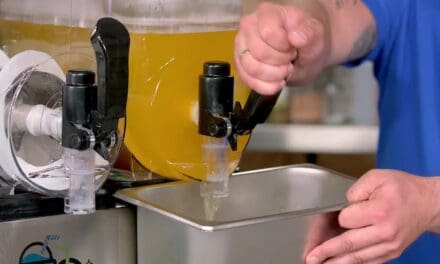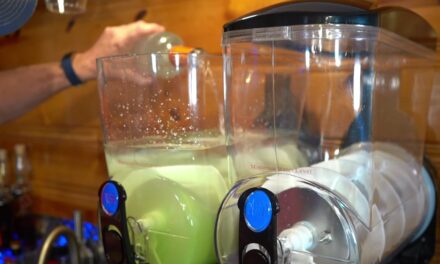Slush beverages are a refreshing staple, especially during warm weather, delighting customers with their icy texture and vibrant flavors. For business owners, they offer a lucrative opportunity, but profitability depends on smart management of costs and quality. Whether you’re running a convenience store, a carnival stand, or a specialty café, understanding the factors that drive slush drink profits is essential. In this comprehensive guide, we’ll explore how to optimize your slush beverage operation, from choosing the right concentrate mix to setting prices that maximize margins. Plus, we’ll provide a practical calculator to help you find the perfect mix ratio for your business.
The Importance of the Slush Mix Ratio
The syrup-to-water mix ratio is the cornerstone of your slush beverage operation. It determines both the flavor intensity and the cost per serving, directly impacting your cost of goods sold (COGS) and customer satisfaction.
Common ratios range from 1:4.5 to 1:6 (concentrate to water). A higher water ratio means more slush from the same amount of concentrate, reducing costs. For example, a 1:6 ratio yields 7 liters of slush from 1 liter of concentrate, while a 1:4.5 ratio produces only 5.5 liters.
However, diluting too much can weaken the flavor, potentially turning off customers and limiting your ability to charge premium prices. Conversely, a stronger mix (e.g., 1:4) enhances taste, allowing you to justify higher prices, but it increases ingredient costs. Striking the right balance is crucial for profitability.
Cost of Slush Concentrate
The price of slush concentrate varies by brand and flavor, typically ranging from $9 to $20 per gallon. For instance, Carnival King’s lemon slushy concentrate costs $9.49 per gallon, yielding about 48 16-ounce servings at a 1:5 ratio. Premium or novelty flavors, like SLUSH PUPPiE’s Warheads Watermelon, may cost closer to $20 per gallon due to their unique appeal. Higher-grade concentrates increase COGS but can support higher selling prices, especially in specialty markets.
Yield and Serving Sizes
The yield from each unit of concentrate is a key driver of profitability. Since water is nearly free, a higher water ratio maximizes the volume of saleable product. For example, a 5-liter case of concentrate at a 1:5 mix ratio produces 30 liters of slush—enough for approximately 100 300 ml servings.
Serving sizes also affect revenue and costs. Common cup sizes include 12 oz, 16 oz, and 24 oz, with selling prices ranging from $1.29 to $3.50, depending on the venue. Convenience stores might charge $1.29 for a 12 oz cup, while specialty locations can command $3.50 for a 24 oz serving. Larger cups boost sales but increase ingredient usage, so pricing must reflect these costs.
Pricing Strategy for Healthy Margins
Setting the right price is critical to achieving strong profit margins. Industry standards suggest that frozen non-carbonated slush drinks average 50–60% profit margins, while carbonated versions can reach 70% due to CO2 adding volume at minimal cost. To maintain healthy margins, keep COGS below 30–40% of the selling price. For a $2.00 slush, aim for a COGS of $0.80 or less.
For example, using Carnival King’s concentrate at $0.20 per 16 oz serving and $0.15 for additional materials (cups, straws), total COGS is $0.35. Selling at $3.99 yields a profit of $3.64, or a 91% margin, far exceeding the target.
Equipment and Operational Costs
Investing in a slush machine is a significant upfront expense, with prices ranging from $500 for small countertop units to $7,000 for multi-tank models (FBD Frozen). Your choice depends on sales volume and budget. Smaller machines offer faster ROI, while larger units provide long-term savings for high-volume operations.
Operational costs include electricity, water, labor, and maintenance. A two-tank slush machine typically costs about $1.60 per day to run, based on average power consumption (Restoanswers). Labor costs for mixing, serving, and cleaning range from $10–$15 per hour per employee, with 1–3 staff needed depending on demand. Routine maintenance is straightforward but essential to prevent downtime.
Inventory Management and Spoilage
Effective inventory management minimizes waste and ensures a steady supply. Liquid concentrates, like those from SLUSH PUPPiE, may require refrigeration and have a one-year shelf life, while powdered mixes offer longer stability. Accurate tracking prevents spoilage, especially for high-volume operations where expired stock can erode profits.
Quality Perception and Pricing Power
The strength of your concentrate mix influences flavor and customer perception. A richer mix, such as a 1:4 ratio, delivers intense flavor, justifying higher prices and fostering repeat business. Over-dilution, while cost-effective, risks disappointing customers, reducing their willingness to pay. Quality is particularly important for premium flavors or branded options like SLUSH PUPPiE’s Blue Raspberry, which can command top dollar.
Carbonated Slushes: A Profit Booster
Carbonated slush drinks offer a unique advantage. Approximately 40–50% of their volume comes from air or CO2, with syrup making up only 10–15% and water 40–50%. This “expansion” increases yield without extra ingredient costs, boosting gross margins to around 70% . If your market supports carbonated options, they can significantly enhance profitability.
Slush Mix Ratio Calculator
To optimize your mix ratio, use this step-by-step guide to calculate the concentrate cost per serving and ensure it aligns with your profit goals:
-
Set your target COGS: For a 60% profit margin on a $2.00 drink, COGS should be $0.80 or less.
-
Estimate other costs: Assume $0.10 per serving for cups, straws, etc.
-
Calculate maximum concentrate cost: $0.80 – $0.10 = $0.70.
-
Know your concentrate cost per liter: For example, $2.50 per liter (based on $9.49 per gallon, or 3.785 liters).
-
Determine serving size: Say, 0.4 liters (400 ml).
-
Find the mix ratio: For a ratio of 1:x (concentrate to water), the concentrate fraction is 1/(1+x). The formula is:
Concentrate cost = [1 / (1 + x)] * serving size * cost per liter ≤ maximum concentrate cost
Example: [1 / (1 + x)] * 0.4 * 2.50 ≤ 0.70
[1 / (1 + x)] * 1.0 ≤ 0.70
1 / (1 + x) ≤ 0.7
1 + x ≥ 1.4286
x ≥ 0.4286
Since typical ratios are 4–6, any x ≥ 0.4286 works, but for flavor quality, choose x=4 or 5.
Alternatively, calculate costs for standard ratios:
|
x |
Ratio |
Concentrate Fraction |
Concentrate per Serving (L) |
Cost ($) |
Total COGS ($) |
Profit ($) |
Margin (%) |
|---|---|---|---|---|---|---|---|
| 4 | 1:4 | 0.2 | 0.08 | 0.20 | 0.30 | 1.70 | 85.0 |
| 5 | 1:5 | 0.1667 | 0.0667 | 0.167 | 0.267 | 1.733 | 86.65 |
| 6 | 1:6 | 0.1429 | 0.0571 | 0.1428 | 0.2428 | 1.7572 | 87.86 |
Assumptions: Concentrate cost = $2.50/L, serving size = 0.4L, other COGS = $0.10, selling price = $2.00.
A 1:5 ratio offers a high margin (86.65%) while maintaining good flavor, making it a popular choice for brands like SLUSH PUPPiE and Carnival King.
Choosing the Right Concentrate
Different brands offer various mix ratios and flavor profiles, affecting both cost and customer appeal. Here’s a comparison of two common options:
|
Brand |
Mix Ratio |
Cost per Gallon |
Servings per Gallon (16 oz) |
Concentrate Cost per Serving |
Notes |
|---|---|---|---|---|---|
|
SLUSH PUPPiE |
1:5 | ~$10–$20 | 48 | $0.21–$0.42 |
Wide flavor variety, premium branding |
|
Carnival King |
1:5 | $9.49 | 48 | $0.20 |
Affordable, reliable for high volume |
Premium concentrates, like SLUSH PUPPiE’s novelty flavors, cost more but can justify higher prices in specialty markets. Neutral bases, available from both brands, allow you to add custom flavors, offering flexibility for unique offerings.
Tips for Maximizing Profitability
-
Experiment with Ratios: Test different ratios to find the best balance of cost and flavor for your customers.
-
Offer Variety: Provide multiple flavors, including carbonated options, to attract a broader audience.
-
Train Staff: Ensure employees are trained in machine maintenance to avoid costly downtime.
-
Use Branding: Leverage branded cups and signage (e.g., SLUSH PUPPiE’s iconic Blue Raspberry) to draw customers.
-
Monitor Demand: Adjust pricing and offerings based on sales trends and customer feedback.
Conclusion
Running a profitable slush beverage business requires careful attention to the mix ratio, pricing strategy, and operational costs. By choosing the right concentrate, optimizing your mix for cost and quality, and managing expenses like equipment and labor, you can achieve impressive profit margins while keeping customers happy. Use the slush mix ratio calculator to fine-tune your approach, and regularly review your operations to stay competitive in this refreshing and rewarding market.
Slush Mix Ratio & Profit Calculator
Calculation Results:
Total Prepared Volume: -- ml
Estimated Servings (Cups): --
Estimated Total Revenue: $--
Estimated Total Profit: $--
Return on Investment (ROI): --%





